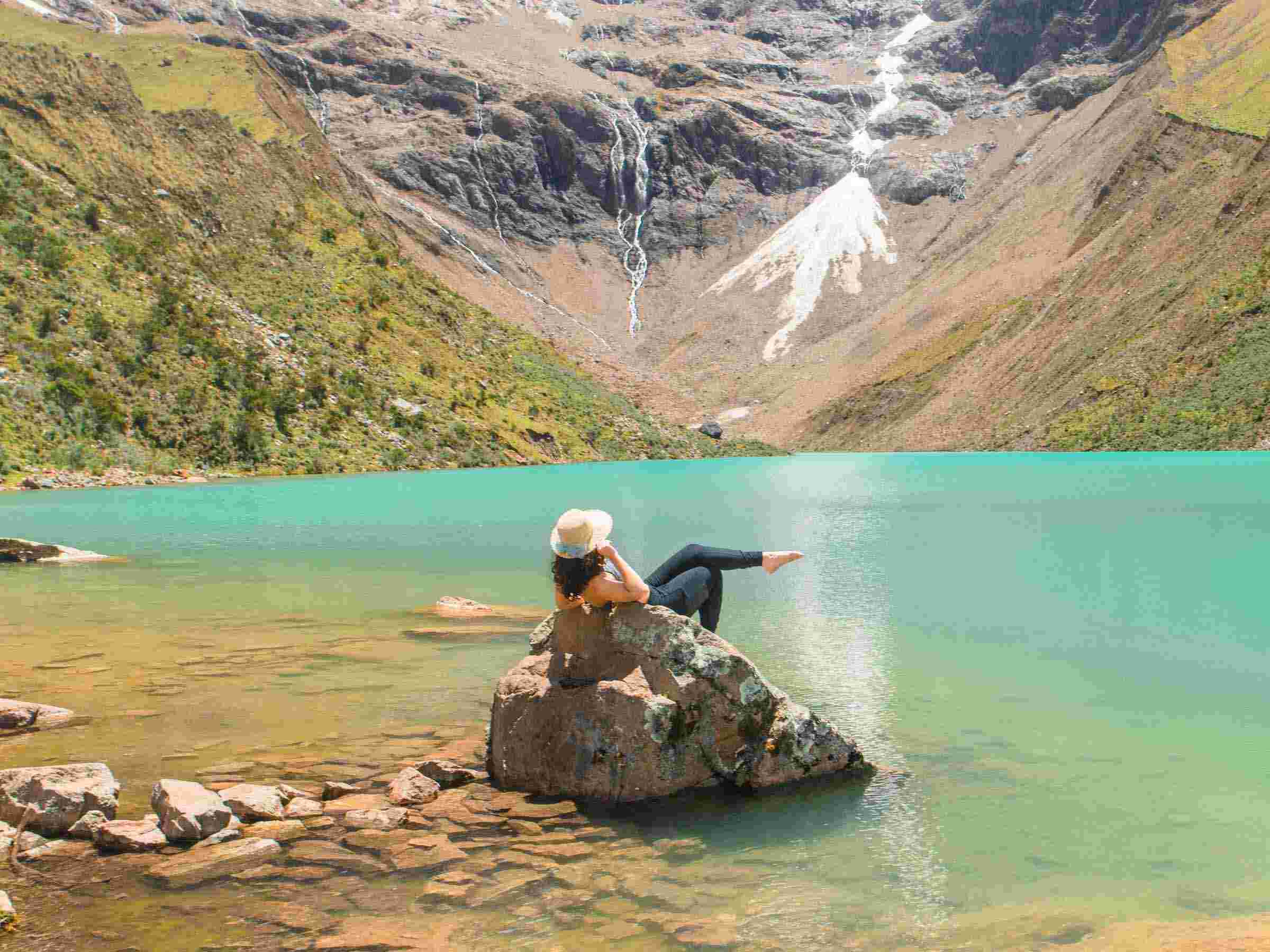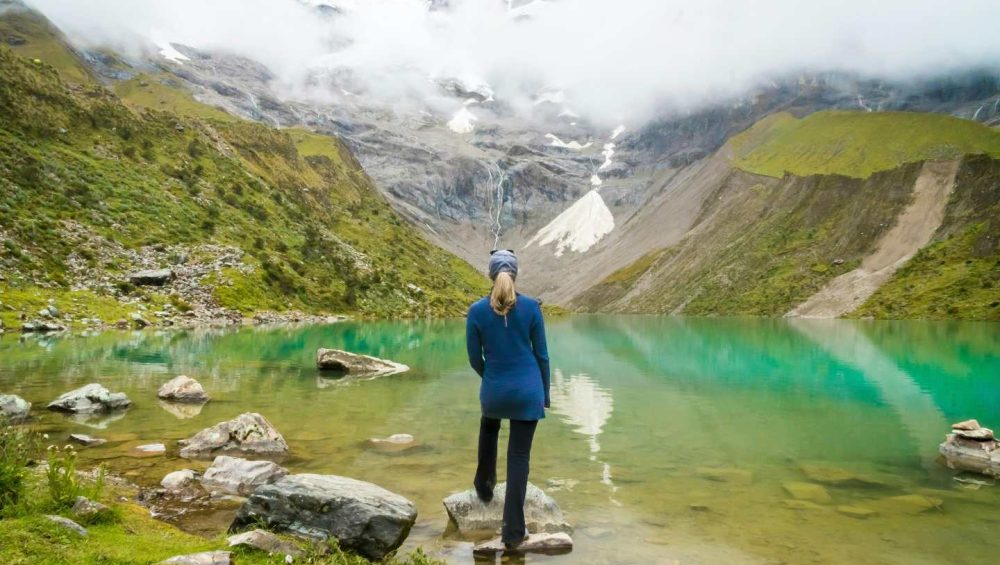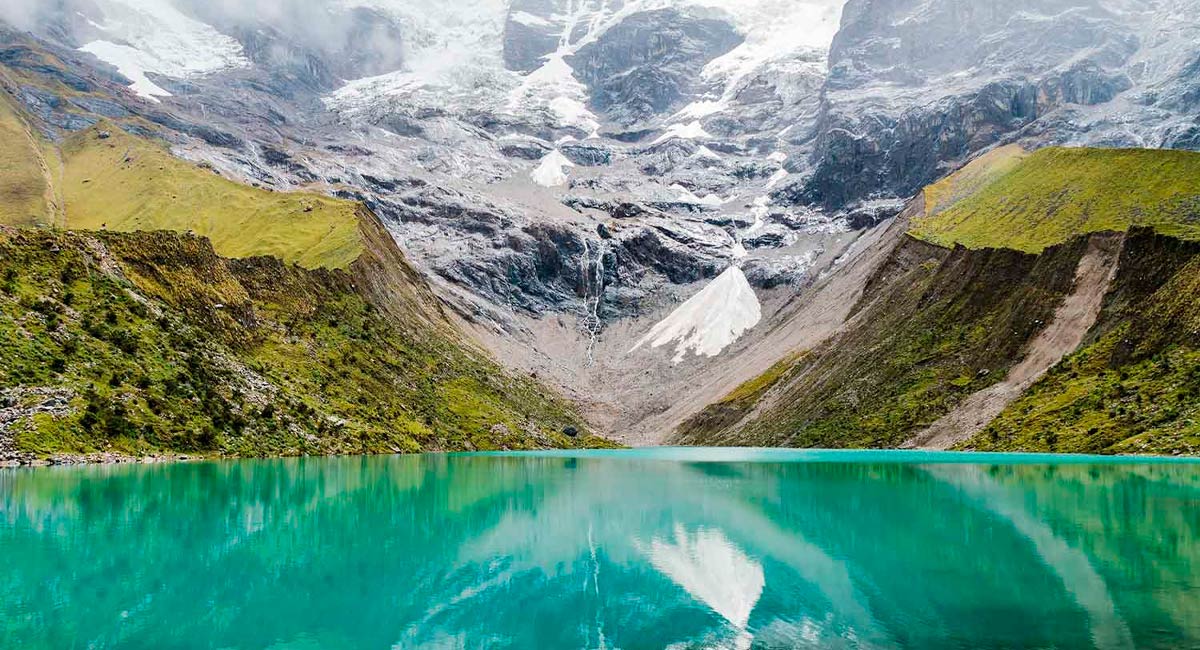Humantay Lagoon dazzles with its turquoise hue, framed by the snow-capped peaks of the Andean mountain range. Located at more than 4,200 meters of altitude, this glacial lagoon has become an icon of the natural landscape of Cusco, standing out for the contrast between its clear waters and the imposing mountainous environment that surrounds it. Its surface precisely reflects the snow-capped mountains, creating a natural postcard that captivates those who behold it.
Its growing popularity is due to both its impressive beauty and its accessibility. From the city of Cusco, it is possible to take a one-day excursion that allows travelers to travel high-altitude roads and reach this Andean corner, considered one of the most photographed in Peru. In addition, its location near the famous Salkantay Trek, the second busiest route to Machu Picchu, makes it an ideal stop for those exploring this region of the country.
About Humantay Lagoon
Humantay Lagoon, located in Peru, is a glacial lake that originates from the melting of the Humantay mountain, one of the peaks that are part of the Salkantay massif in the Cusco region. Its pure waters, enriched with natural minerals, exhibit a changing turquoise tone depending on the light of day and the season of the year.
In the last decade, this destination has gained great popularity, partly because it can be visited on a one-day excursion from Cusco, without the need for camping. This makes it an excellent option for those with limited time who wish to explore high-altitude Andean landscapes. Its color and the surrounding landscape have made the lagoon one of the most photographed settings in Cusco, appearing in digital publications, social media, and tourist programs. Added to this is its cultural relevance, as many people who come to the place participate in rituals of gratitude to Pachamama, making offerings on its banks as a sign of respect and spiritual connection with nature.

Geographical location
The Lagoon is located west of the Vilcabamba Mountain Range, in the district of Limatambo (province of Anta), in the region of Cusco, Peru. It is located at about 4200 m.a.s.l. In this area of the Andean highlands, known for its pastures, wetlands, and puyas, it creates a rugged landscape, ideal for contemplating the high mountains. Its connection with the Salkantay Mountain, which at 6271 m is the second highest peak in Cusco, is very close: Humantay is one of the sources of glacial water for this important mountain massif. From the edge of the lagoon, looking south, you can observe the imposing snowy silhouette of Salkantay, whose peaks feed the constant flow of water that keeps this lagoon alive.
How to get to Humantay Lagoon
Before detailing the route, it is important to note that visiting Humantay Lagoon involves a road trip followed by a high-altitude hike. Given that altitudes exceed 3800 m in Soraypampa and reach approximately 4200 m at the lagoon, it is recommended to spend at least one night in Cusco to acclimatize and reduce the risk of altitude sickness. Although the trip can be completed in one day, many travelers prefer to hire a tour that handles transportation, guiding, and access. Below, the steps and available options to get there are described:
ROUTE 1: From Cusco to Soraypampa
- Distance and time: Approximately 60 km (2 to 3 hours) by road, much of it on mountain roads with sharp curves.
- Starting point: Tours usually depart at dawn from the center of Cusco, although it is also possible to hire private transportation.
- Usual stops: A brief stop is made in Mollepata or Limatambo for breakfast and supplies. From there, the route continues uphill until reaching Soraypampa (3900 m), the starting point of the hike.
ROUTE 2: Hike from Soraypampa to the Lagoon
- Distance and duration: Around 6 km round trip, with a vertical drop of nearly 300 m. The ascent takes between 1 h and 1 h 30 min; the descent, approximately 45 minutes.
- Trail characteristics: Well-defined route, with sections of loose stones and some moderate slopes. During the journey, Andean landscapes and views of the Salkantay snow-capped mountain can be observed.
- Recommendations: It is advisable to use trekking poles for greater stability and to take regular breaks to control pace and breathing.
Alternative transport and organization
- Guided tours: They offer transportation from Cusco, a bilingual guide, breakfast, trekking poles, and, in many cases, local lunch. It is a practical option for those who want a planned experience.
- Independent travel: It is also possible to get there on your own, by renting a 4×4 vehicle or taking collective transportation to Soraypampa. From there, continue on foot to the lagoon.
- Entry and rules: A payment is requested in Soraypampa to access the area. This amount is collected by the local community and is used for the maintenance of roads and basic services.
Characteristics of Humantay Lake
- Color of its waters: Humantay Lake stands out for its turquoise hue, a result of minerals transported by melting glaciers. Elements such as mica and calcium carbonate present in the water scatter sunlight, creating a bluish-green tone that varies throughout the day: brighter under the midday sun and softer in the early morning or late afternoon. The intensity of the color also changes according to the season, melting, and weather conditions.
- Vegetation and nearby fauna: The natural environment of Humantay resembles a high Andean meadow. On its slopes grow plants such as ichu, a grass adapted to extreme cold, and puya Raimondi, a large native species. Among the rocks, it is common to observe vizcachas (Lagidium peruanum), while in the sky, birds such as the mountain sparrow fly and, occasionally, the majestic Andean condor, which glides over the glacial valleys.
- View of Humantay Mountain: From the shore, the lake offers a clear view of the Humantay mountain, whose snowy summit rises above the landscape. The combination of glacial white, the gray of rock formations, and the turquoise of the water creates a scene of strong contrasts. This view allows observing natural phenomena such as ice advance and typical geological features of the Peruvian Andes.
Climate and temperature in Humantay Lake
Located in the Peruvian Andes, Humantay Lake presents a cold and variable climate, typical of high-altitude areas. Temperatures fluctuate significantly between day and night, requiring adequate preparation for each day of the trip.
Seasons
- Dry season (May to September): During these months, clear skies prevail, and the probability of rain is low, which allows walking the trails more comfortably. Daytime temperatures range between 8°C and 12°C, while at night the cold can intensify, reaching up to -10°C on the coldest mornings.
- Rainy season (October to April): Precipitation is frequent, especially in the afternoons, and the sky usually remains covered. Maximum temperatures tend to be slightly lower (between 6°C and 10°C), and minimum temperatures continue to be very cold, reaching values between -2°C and -7°C. At this time, paths can become more unstable and slippery.
Difficulty of the Hike
The trek to Humantay Lake, while relatively short (approximately 6 km in total), includes a steep incline in its final section, in addition to the demands of the thin air due to the altitude. This combination makes the hike a moderate challenge, especially for those not accustomed to terrain above 3,500 m.a.s.l. Below are some key aspects of its level of demand:
Physical Demand
- Elevation change and distance: From Soraypampa to the lake there is an ascent of about 300 meters in just 2 km.
- Terrain: The path consists of compact dirt with sections of loose stones and meltwater channels, which can make progress difficult at times.
- Estimated duration: It is estimated to take between 1.5 to 2 hours to go up and between 1 to 1.5 hours to go down, depending on the pace and breaks taken for acclimatization or taking photos.
- Suggestion: It is advisable to move at a steady pace, take brief breaks, and use trekking poles to relieve stress on the joints.
Recommended Activities
Scenic walk
The journey to the lake offers an enriching experience with every step. The path crosses open areas surrounded by grasslands and offers constant views of the Salkantay snow-capped mountain. During the ascent there are several elevated points from which you can observe the Andean geography and the native fauna of the region. The final, steeper part of the trail culminates with the spectacular appearance of the turquoise-colored lake.
Important Fact: This route is also part of the famous trek to Machu Picchu via the Salkantay route, and represents one of the most admired segments of the journey.
Landscape photography
Humantay Lake is an ideal destination for those who enjoy capturing natural settings. The contrast between the blue of the water, the white of the glaciers, and the rocky tones offers a scene of great beauty. It is recommended to bring a wide-angle lens to capture the expanse of the environment, and a polarizing filter to enhance colors and eliminate reflections. The best times to photograph are sunrise and sunset, when the light casts defined shadows and highlights every detail of the landscape.
Andean Ceremonies (Offerings to Pachamama)
Once at the lake, many visitors decide to pay homage to Pachamama with small rituals. These offerings usually include coca leaves, flowers, and corn kernels, carefully arranged on stones along the shore. This gesture represents an ancestral tradition of respect and gratitude towards the Earth.
What to bring for your visit to Humantay Lake?
Being well prepared makes a big difference on this type of excursion. Weather conditions in the area can change rapidly: the sun can be strong during the day, while the cold intensifies in the late afternoon. Therefore, it is essential to have layered clothing, sun protection, appropriate footwear, water, energy snacks, and a windproof jacket. A comfortable and light backpack will also make the journey easier and allow you to enjoy the Andean environment with greater peace of mind.


